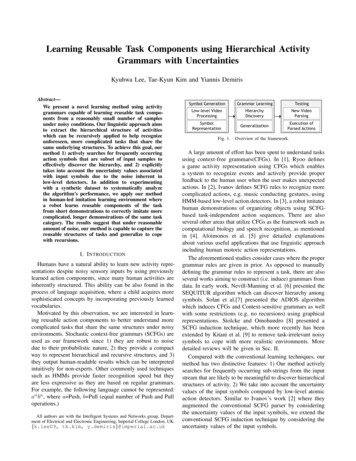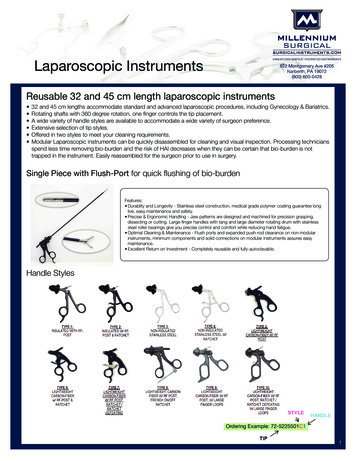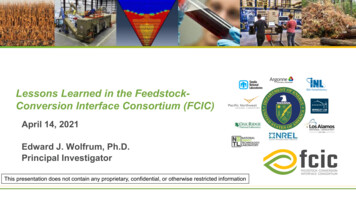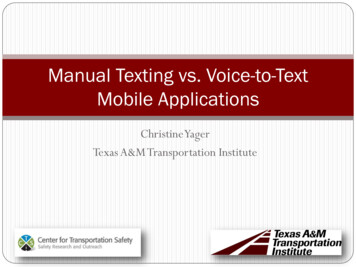
Transcription
Learning Reusable Task Components using Hierarchical ActivityGrammars with UncertaintiesKyuhwa Lee, Tae-Kyun Kim and Yiannis DemirisAbstract—We present a novel learning method using activitygrammars capable of learning reusable task components from a reasonably small number of samplesunder noisy conditions. Our linguistic approach aimsto extract the hierarchical structure of activitieswhich can be recursively applied to help recognizeunforeseen, more complicated tasks that share thesame underlying structures. To achieve this goal, ourmethod 1) actively searches for frequently occurringaction symbols that are subset of input samples toeffectively discover the hierarchy, and 2) explicitlytakes into account the uncertainty values associatedwith input symbols due to the noise inherent inlow-level detectors. In addition to experimentingwith a synthetic dataset to systematically analyzethe algorithm’s performance, we apply our methodin human-led imitation learning environment wherea robot learns reusable components of the taskfrom short demonstrations to correctly imitate morecomplicated, longer demonstrations of the same taskcategory. The results suggest that under reasonableamount of noise, our method is capable to capture thereusable structures of tasks and generalize to copewith recursions.I. I NTRODUCTIONHumans have a natural ability to learn new activity representations despite noisy sensory inputs by using previouslylearned action components, since many human activities areinherently structured. This ability can be also found in theprocess of language acquisition, where a child acquires moresophisticated concepts by incorporating previously learnedvocabularies.Motivated by this observation, we are interested in learning reusable action components to better understand morecomplicated tasks that share the same structures under noisyenvironments. Stochastic context-free grammars (SCFGs) areused as our framework since 1) they are robust to noisedue to their probabilistic nature, 2) they provide a compactway to represent hierarchical and recursive structures, and 3)they output human-readable results which can be interpretedintuitively for non-experts. Other commonly used techniquessuch as HMMs provide faster recognition speed but theyare less expressive as they are based on regular grammars.For example, the following language cannot be represented:an bn , where a Push, b Pull (equal number of Push and Pulloperations.)All authors are with the Intelligent Systems and Networks group, Department of Electrical and Electronic Engineering, Imperial College London, UK.{k.lee09, tk.kim, y.demiris}@imperial.ac.ukSymbol GenerationGrammar LearningTestingLow-level VideoProcessingHierarchyDiscoveryNew ution ofParsed ActionsFig. 1.Overview of the framework.A large amount of effort has been spent to understand tasksusing context-free grammars(CFGs). In [1], Ryoo definesa game activity representation using CFGs which enablesa system to recognize events and actively provide properfeedback to the human user when the user makes unexpectedactions. In [2], Ivanov defines SCFG rules to recognize morecomplicated actions, e.g. music conducting gestures, usingHMM-based low-level action detectors. In [3], a robot imitateshuman demonstrations of organizing objects using SCFGbased task-independent action sequences. There are alsoseveral other areas that utilize CFGs as the framework such ascomputational biology and speech recognition, as mentionedin [4]. Aloimonos et al. [5] give detailed explanationsabout various useful applications that use linguistic approachincluding human motoric action representations.The aforementioned studies consider cases where the propergrammar rules are given in prior. As opposed to manuallydefining the grammar rules to represent a task, there are alsoseveral works aiming to construct (i.e. induce) grammars fromdata. In early work, Nevill-Manning et al. [6] presented theSEQUITUR algorithm which can discover hierarchy amongsymbols. Solan et al.[7] presented the ADIOS algorithmwhich induces CFGs and Context-sensitive grammars as wellwith some restrictions (e.g. no recursions) using graphicalrepresentations. Stolcke and Omohundro [8] presented aSCFG induction technique, which more recently has beenextended by Kitani et al. [9] to remove task-irrelevant noisysymbols to cope with more realistic environments. Moredetailed reviews will be given in Sec. II.Compared with the conventional learning techniques, ourmethod has two distinctive features: 1) Our method activelysearches for frequently occurring sub-strings from the inputstream that are likely to be meaningful to discover hierarchicalstructures of activity. 2) We take into account the uncertaintyvalues of the input symbols computed by low-level atomicaction detectors. Similar to Ivanov’s work [2] where theyaugmented the conventional SCFG parser by consideringthe uncertainty values of the input symbols, we extend theconventional SCFG induction technique by considering theuncertainty values of the input symbols.
In this paper we study how learning activity grammarscan be learned from human partners. We assume that 1) thesystem can detect meaningful atomic actions which are notnecessarily noise-free, and 2) extensive complete data setsare not always available but numerous examples of smallercomponent elements could be found.II. R ELATED W ORKOur framework (Fig. 1) shares the concept of imitationlearning presented in [10], [11], where a robot learns a newtask directly from human demonstration without the need forextensive reprogramming. We are inspired by the work in [12]which shares the same motivation of hierarchical learningwith our work. In their work, the authors designed a set ofprimitive actions which are then used as building blocks,i.e. basic vocabularies, to represent higher-level activities.However, it does not deal with more complex concepts suchas recursions which we will deal with here.In [8], Stolcke and Omohundro proposed a techniqueon merging states which generalizes SCFG rules to dealwith unforeseen input with arbitrary lengths, e.g. symbolsgenerated by recursive rules. They introduce two operators,chunking and merging, which convert an initial naive grammarto a more general one. The method assumes that inputterminal symbols are deterministic, i.e. all symbols areequally meaningful and do not contain any certainty values.Our method is different in that it takes into account theuncertainty (or probability) values of input symbols andexplicitly searches for regularities using n-gram-like frequencytable within each input sample. This allows us to generalizethe rule more effectively with the same amount of datasamples that better represents data.More recently, Kitani et al. [9] presented a frameworkof discovering human activities from video sequences usingSCFG induction technique based on [8]. By assuming thatthe noise symbols are not part of the task representation,they try excluding some symbols from input stream until agrammar with strong regularity is found based on minimumdescription length (MDL) principle. However, because noisesymbols are not assumed to be part of task representation,it is limited to dealing with insertion errors where wrongsymbols are accidentally inserted.III. BACKGROUNDA. Stochastic Context-Free Grammar InductionA context-Free Grammar (CFG) is defined by a 4-tupleG {Σ, N, S, R}, where Σ is the set of terminals, N is theset of non-terminals, R is the set of productions rules, andS is the start symbol. The production rules take the formX λ, where X N and λ (N Σ) . Non-terminals aredenoted in uppercase letters while terminals are denoted inlowercase letters. In Stochastic CFG (SCFG), also known asProbabilistic CFG (PCFG), each rule production is assignedcontinuous probability parameters.To induce an activity grammar from input data (terminalsymbols), first an initial naive grammar is built as the startingpoint by adding all input sequences to the start symbol S.Starting from the initial grammar, two kinds of operators,Substitute and Merge, are applied until the ”best” grammar isfound. The quality of a grammar is measured by the MinimumDescription Length (MDL) principle as used in [13][9][8],which will be explained more in Sec. III-B.The Substitute operator builds hierarchy by replacing apartial sequence of symbols in the right-hand side of a rulewith a new non-terminal symbol. The new rule is created suchthat a new non-terminal symbol expands to these symbols. TheM erge operator generalizes rules by replacing two symbolswith the same symbol. As a result, it converts the grammarinto the one that can generate (or accept) more symbols thanits predecessor while reducing the total length of the grammar.B. Measuring the Quality of a GrammarThe general objective is to find a grammar that is sufficiently simple yet expressive as pointed out by Langley et al.[13] We denote P (M ) as a priori model probability, whereM includes only the structure and parameter priors whichdoes not consider the input data D, and P (D M ) as datalikelihood. Then, our goal is to minimize the MDL score as-log of joint probability P (M, D): logP (M, D) logP (M ) logP (D M )(1)The data likelihood P (D M ) is computed using Viterbiparsing, which is commonly used in HMMs. However, unlike[8] and [9], to handle the uncertainty values of the inputsymbols, the method of computing the likelihood needs tobe modified. To cope with this situation, we use the SCFGparsing algorithm with uncertainty input introduced in [2] tocompute data likelihood.IV. P ROPOSED M ETHODWe first explain our method of computing the rule probabilities in the first section, followed by considering symbolswith uncertainty values.A. Active Substring DiscoveryTo generate a grammar that focuses on patterns with strongregularity, we build an n-gram-like frequency table such thatit keeps the number of occurrences of substrings that aresubset of input sequences. The score of a rule X λ is theoccurrence value of λ in the frequency table multiplied bythe expected probability value of λ. Its calculation will bediscussed in the following section, Sec. IV-B.For simplicity, we first consider the case without uncertaintyvalues. In this case, as defined in [8] and [9], the ruleprobability is calculated by normalizing rule scores, i.e.:f (X λi )P (X λi ) Pk f (X λk )(2)where λi is the i-th rule production of non-terminal X andf (·) denotes the frequency of the string. P (X λi ) satisfiesthe following property:XP (X λi ) 1(3)i
(a)S ABABABAB (6) [0.86] ABACABAB (1) [0.14](b)S ZZ (6) XYZ (1)X AB (27)Y AC (1)Z XX (13)[0.86][0.14][1.00][1.00][1.00](c)S ZZ (7)X AB (27) AC (1)Z XX (13)[1.00][0.96][0.04][1.00](d)S ZZ (7)Z AB (27) AC (1) ZZ (13)[1.00][0.66][0.02][0.32](e)S SS (20) [0.42] AB (27) [0.56] AC (1) [0.02]Fig. 2. (a) Initial naive grammar (b) After Substituting AB with X,AC with Y , and XX with Z (c) After M erging (X, Y ) to X (d) AfterM ergeing (X, Z) to Z (e) After M erging (S, Z) to SUnlike [8] and [9], the symbol counts are computed directlyfrom the occurrences of each input sequence as whole, notsubset. However, in our method, as we keep counts for allpossible sub-patterns from input samples, the probability ofeach rule is always larger than zero even if there was no inputsequence that exactly matches the discovered sub-pattern. Thishas an effect of stronger “inductive leap”, i.e. higher tendencyto generalize from relatively small number of input samples.To illustrate, suppose that we want to learn an activity withrepetitions (ab)n from the 6 correct samples of “abababab”and 1 erroneous sample of “abacabab”. The initial naivegrammar (Fig. 2(a)) simply contains all input sequences.Weuse parentheses (·) and brackets [·] to represent counts andprobability, respectively. We now apply a Substitute (Fig.2(b)) and Merge operators (Fig. 2(c)-(e)) introduced in [8]with rule scores obtained from our frequency table. We haveobtained a more generalized grammar that favors (yieldinghigher probability when parsed) input sequences mostlycontaining AB’s. It is worth noting that the rule probabilityof erroneous symbol AC is still in the grammar but with verylow probability. As a result, this grammar “allows” occasionalerrors as it still accepts noise cases with low probabilityinstead of simply rejecting. This “soft” classification is oneof the advantages of SCFGs.In practice, it is often useful to limit the maximum lengthof symbols to be considered in frequency table to avoidgenerating exhaustive list of symbols to increase the speed.This is reasonable assumption as human activities usuallyinvolve repetitive action components[14]. Since the searchspace of the possible grammars is not small, a beam searchstrategy is applied as in [8] which considers a numberof relatively good grammars in parallel and stops if acertain neighborhood of alternative grammar models has beensearched without producing further improvements.B. Considering Input Samples with UncertaintySo far, we have only considered a case where inputsymbols are non-probabilistic, i.e. terminals (a, b, c.) arenot assigned with probability values. However, since weassume that low-level action detectors could also provideuncertainty (confidence) values as output, it is beneficial toexploit this information. If there is higher rate of noise, it ismore likely that the certainty of a symbol is lower. Basedon this assumption, we first compute the probability of asub-pattern λ s1 s2 s3 .sn of length n from input, asY1P (λ) ( P (sn )) n(4)nThe term n1 is used to normalize the probability as theprobability will always decrease as λ gets lengthier. Theexpected value of λ is obtained by averaging all occurrencesof λ in the input. Thus, we modify the equation (2) asf (X λi )µ(λi )P (X λi ) Pk f (X λk )µ(λk )(5)where µ(·) denotes the expected value and i denotes the i-thrule of X. We use this equation throughout our experiments.In our method, we define the model prior probabilityP (M ) P (MS , Mθ ) P (MS )P (Mθ MS )(6)where P (MS ) denotes structure prior and P (Mθ ) denotesparameter prior. As in [8] and [9], P (MS ) is defined as Poisson distribution with mean (average production length) 3.0.P (Mθ MS ) is defined as the product of Dirichlet distributions,such that each Dirichlet distribution represents uniformlydistributed probability across all possible productions of anon-terminal symbol X, i.e.:PX (Mθ MS ) nY1θi αi 1 ,β(α1 , ., αn ) i 1(7)where β is a beta distribution with parameters αi , and θi isthe rule probability which are uniformly distributed. Sincewe have no prior knowledge about thePdistribution of thengrammar parameters, αi αj i, j and i αi 1V. E XPERIMENTS AND A NALYSISTo test our framework, we first experiment on syntheticdata with systematically varying the levels of noise, followedby real-world data obtained from camera. As MDL scoresdepend on the data samples, we compute the ratio values ofMDL scores between the learned grammar and the hand-mademodel grammar.We apply pruning process as in [8] to speed up theinduction and filter out non-critical production rules havingprobabilities lower than some threshold τ , as they are oftenaccidentally created due to noise. If the removal of a ruledecreases the description length of model prior but increasesthat of data likelihood in relatively small amount, it will leadto a better (lower) MDL score. We set τ 0.01 in all of ourexperiments.A. Bag-of-Balls ExperimentIn this experiment, we assume a scenario where arbitrarynumber of balls are inserted into a bag (denoted as a), movedto another place (denoted as b), and the same number of ballsare taken out later (denoted as c), which can be representedin the form an bcn . The samples are randomly generated fromthis model grammar up to the length of 9 (n 4).To test over noise sensitiveness, we add Insertion andSubstitution errors. An Insertion error inserts a random symbolinto the input and a Substitution error randomly replaces
(a)S Y(8.00) AYC(3.00) AABAC(1.00) AACACCCC (1.00) AAYCC(1.00) CY(1.00)Y AABCC(8.00)Quality Score2.82.6Proposed2.4Kitani et al.2.2Stolcke et 180.2Noise LevelFig. 3. Quality scores of grammars generated by various methods. Thelower score indicates that the grammar is more compact yet maintains enoughexpressive power.500Stolcke et al.Kitani et al.ProposedModel450400MDL 00.120.140.160.180.20Noise LevelFig. 4. Actual MDL scores for each method compared with the modelgrammar. MDL scores are averaged over 10 trials for each noise condition.The graph is shown with 2% step for better view. The lower score indicatesthat the grammar is more compact yet reasonably expressive. How thesescores affect the performance in real world will be discussed in Sec. V-Ba symbol with any incorrect one. We test with the noiseprobability in the range of [0%, 20%] with 1% step, totalingin 21 noise conditions. A noise probability of 10% meansthat either a Substitution or Insertion error has occurred inapproximately 10% of the input symbols. Each noise conditionis conducted 10 times with randomly generated dataset and itsmean MDL score is computed, resulting in 210 experimentsin total. We conduct each experiment with two previouslyreviewed methods reported by Kitani [9] and Stolcke [8].The confidence values of terminal symbols are given suchthat the correct symbol is assigned with the probabilitycomputed from Gaussian distribution with µ 0.85, σ 0.1and wrong symbol with µ 0.15, σ 0.1. We set unrelatedsymbol d to be included as noise, as in [9].The quality score of a grammar is the ratio of MDL scoresbetween learned grammar and the model grammar, where thelower score indicates that the grammar is more compact yetmaintains enough expressive power. Fig. 3 shows the qualityscores over various noise conditions, where in most casesthe grammars generated by our proposed method have thelowest quality scores implying that they are well-balancedbetween compactness and expressiveness.As qualitative analysis, we now examine some of theobtained grammars. In the case with noise probability 0.08, agrammar obtained using the method proposed in [9] is shownin Fig. 5(a). Under this noise condition, the mean MDL scorewas 330.38 and the standard deviation was 39.72. A grammarobtained using our proposed method under the same noisecondition with the same dataset is shown in Fig. 5(b). Themean MDL score was 300.62 and the standard deviation was48.27. The average MDL scores can be seen in Fig. 4.[0.53][0.20][0.07][0.07][0.07][0.07][1.00](b)S AABCC (6.99) ASC(2.66) AASCC (0.93) CS(0.64) AABAC (0.46)[0.60][0.23][0.08][0.05][0.04]Fig. 5. Obtained grammars using method in [9](a) and proposed method(b)from data with noise probability 0.08.It is worth noting that the rule scores in the grammargenerated using our method reflect the uncertainty valuesof input symbols. As a result, in Fig. 5(b) the erroneoussequence AABAC (the last rule) has a rule score of 0.46in contrast to 1.00 in Fig. 5(a), as the symbol C had lowerprobability (higher uncertainty) due to noise. In the secondgrammar, since rules containing noise quickly converged tovery low probability (less than 0.01) and pruned, the ruleprobability for the correct cases, e.g. S AABCC hasrelatively higher probability value. This will result in higherlikelihood when parsed on new samples with the same class.In the following section, we show how MDL scores actuallyreflect the performance in several real world scenarios.B. The Towers of HanoiWe try our method on real-world data obtained from thedemonstrations of 5 human participants using a camera. Weset our goal to be a successful imitation where a robot followsthe correct sequence of actions demonstrated by a humanpartner. However, instead of simply imitating, we requirethat the robot should deal with noise using the knowledgeobtained in prior so that it can perform the intended actionsequence correctly even when the perceived symbols arepartially incorrect. Furthermore, we are interested in tasksthat include recursion which can be demonstrated in variouslengths of action sequences, resulting in more challengingsetting. We choose The Towers of Hanoi problem as it satisfiesthe above requirements.1) Experiment Scenario : In training phase, a humandemonstrator solves the puzzle using only 2 and 3 disks,repeating each 3 times. The robot then learns an activitygrammar from each demonstrator using techniques explainedin Sec. IV. Thus, 5 activity grammars are learned in total.In testing phase, a human demonstrator solves the puzzleusing 4 disks, repeating 3 times. The trained activity grammaris used to parse the observation, which generates a sequenceof actions to execute. A reproduction is considered a successonly if the robot solves the puzzle by correctly executingthe complete sequence of actions. Each activity grammar isused to parse each demonstration, which results in 15 testsfor each of our 5 participants, or 75 in total. Fig. 7 showsthe end state of a reproduction using the iCub simulator (seeassociated video file in the proceedings).We experiment under two types of noise conditions:low-noise (indoor lighting) and high-noise (direct sunlight)conditions. That is, a) train on low-noise condition and teston both low- and high-noise conditions, respectively, and b)
Fig. 6. A sample tracking screen while a human participant is solving thepuzzle with 4 disks. Compared to the left figure (low-noise condition), theright figure (high-noise condition) shows over-exposured spots which oftenmakes the tracker unstable. The tracker immediately resets the position iflost by searching the desired blob from the entire region of the image.SymbolLDABCFig. 7. The Towers of Hanoi. iCubis performing parsed actions.[15]ActionsLift a diskDrop a diskMove between 1 and 2Move between 1 and 3Move between 2 and 3Fig. 8. Actions defined in Towersof Hanoi experiment. The systemis equipped with these 5 primitiveaction detectors which generatessymbol probability during observation.train on high-noise condition and test on both conditions. Allsamples of high-noise data set were captured in the same dayfor consistency. Example samples can be seen in Fig. 6.Since we are interested in high-level task representations,we assume that the system can detect minimal level ofmeaningful actions and generate symbols. Similar to [2],we define these atomic action detectors using HMMs whereeach model corresponds to an action symbol with its outputvalue representing the symbol’s certainty, or probability value.In this experiment, our system generates 5 types of actionsymbols during observation as detailed in Fig. 8. The reasonwe define symbols like Disk moved “between” A and Binstead of Disk moved “from” A to B is because they aresufficient to represent the task which can avoid generatingexcessive number of symbols. As the rule of the puzzleenforces that only a smaller disk shall be placed on top ofthe bigger disk, there is always only a single possibility ofmoving a disk between two towers. This is a fair assumptionas this rule is always given in prior, not learned. Thus, interms of executing symbols A, B, and C, we can expect thatthe robot will make the correct move. During the trainingphase, the symbol with the highest certainty is fed into theinput of the grammar building algorithm.If we denote action sequences LAD as X, LBD as Y , andLCD as Z, then symbols X, Y , and Z represent pick-andplace action sequences. The optimal solution of the puzzlecan represented as (XY Z)n , meaning “Perform (XY Z)recursively until the problem is solved.”We use a camera with resolution 640x480, 30 framesper second. Object trackers are implemented using standardCamShift algorithm provided in [16], with additional Kalmanfiltering to improve stability. A sample tracking screen isFig. 9. Success rates using our method, base method [8] and pure imitation.Scenarios LL and LH: Train on low-noise condition and test on low- andhigh-noise conditions, respectively. Scenarios HL and HH: Train on highnoise condition and test on low- and high-noise conditions, respectively. Thefact that a single mistake while parsing a long test sequence causes a failuremakes this problem non-trivial.Scenario Method Success Avg.MDL Scenario Method Success 9.46Imitation25N/AImitation15N/AFig. 10. Detailed results with average MDL scores for comparison. Eachcase is tested on 75 sequences. MDL score is not available for pure imitationas it does not rely on any learned model. It is worth noting that lower MDLscore generally leads to higher success rate.shown in Fig. 6. As it depends on the color information ofblobs, it often produces errors due to lighting conditions.2) Results and Analysis: As explained in the last section,the objective here is to learn a high-level task representationfrom a few short sequences of demonstrations that can be usedto better parse the unforeseen, possibly more complicatedactivities that shares of same action components. We reportthe performances in 4 scenarios (LL, LH, HL, HH) in Fig. 9.In scenarios LL and LH, models are both trained fromdemonstrations of 2 and 3 disks under low-noise condition,where they are tested on demonstrations of 4 disks onlow-noise and high-noise conditions, respectively. Similarly,scenarios HL and HH are trained from high-noise conditionand tested on both noise conditions.We compare with the base method [8] and pure imitationmethod which simply follows what has been observed fromdemonstrations. In any case, if the system makes any singlemistake while recognizing human demonstration due to eitherwrong tracking or wrong symbol interpretation, it is markedas failed. This makes our scenarios non-trivial as each testingsequence is composed of 45 symbols. Please refer to Fig. 11to see error statistics. We do not use the method proposed byDemonstrations using 4 disksTotal number of sequencesSequences containing wrong symbolAverage error symbols per .67Fig. 11. Error statistics of demonstrations using 4 disks on each noisecondition. Note that even in low-noise condition, there are only 5 trialsobserved with all correct symbols, which means that in most cases pureimitation will not lead to the desired goal state. Each testing sequence iscomposed of 45 action symbols, which makes this problem non-trivial asonly a single mistake will make it fail to achieve the goal.
(a)S LAD LBD LCD CADSS SLBAS 84][0.388758](b)S LADLBDLCD [0.666667][0.285714] SSLAD[0.047619] SSSSSFig. 12. (a) A sample grammar that captured the meaningful actioncomponents such as LAD, LBD, and LCD (lines 1-3). These componentscan be used to enforce the observation to be consistent with the demonstrator’sintended actions. CADSS and SLBAS (lines 4-5) come from noisyexamples and since their frequencies in training data are very low, they areassigned much lower probabilities. (b) A sample grammar constructed in anideal case where no noise symbols exist.Kitani et al[9] in this experiment as all generated symbolsare always related to the task.As can be seen in Fig. 9, it is important to note that there isa noticeable difference on base method between scenarios LLand HL, and between LH and HH. As scenarios HL and HHare trained from noisy training data, the task representationscould be easily corrupted. This could even lead to parse thecorrect symbol into wrong symbol which results in worseperformance than purely imitating observed actions, whereasour method at least performs better than pure imitation.It is also worth noting that from Fig. 10, we can confirm thatlower MDL score leads to generally better representations. Amodel with the highest MDL score 469.46 (scenario HH, Basemethod) had the poorest performance, where a model with thelowest MDL score 284.63 (scenario LL, Proposed method)exhibited the best performance. As expected, models learnedin high-noise condition tend to have lengthier descriptions,which increases prior score. Relatively high MDL scoresgenerally mean that they are too specific, failing to capturethe recursiveness nature of the task.The example grammar constructed using the proposedmethod (Fig. 12(a)) shows that it captured meaningful actioncomponents: LAD, LBD, and LCD. (lines 1-3) Althoughthere are intermittent error symbols in input sequences, theunderlying structures of action components are capturedeffectively. It is worth emphasizing that this structure enablesthe contextually consistent parsing of new observations. Forexample, the learned action component LAD allows theaction DROP (D) to be expected when MOVE BETWEEN(A) action is observed, even if DROP action was missed ormisinterpreted. The last line of the grammar rules shows thatit also captured the recursiveness nature of the task.Although each model is constructed only from 6 samplesequences, it successfully captured these core componentsdue to active substring searching explained in Sec. IV-A. Fig.12(b) shows an example grammar constructed from data thatcontains no noise at all. Most of the experiments, however,includes noise symbols in the middle of input sequenceswhich hinders the discovery of the full meaningful actioncomponent such as LADLBDLCD in Fig. 12(b), line 1.Nevertheless, grammars discovered like the one in Fig. 12(a)worked reasonably well to support parsing the same task withmore complicated sequences.VI. C ONCLUSIONS AND F UTURE D IRECTIONSWe have presented an activity grammar learning methodwhich searches for frequently occurring sub-strings from theinput stream that are likely to be reusable conside
Kyuhwa Lee, Tae-Kyun Kim and Yiannis Demiris Abstract— We present a novel learning method using activity grammars capable of learning reusable task compo-nents from a reasonably small number of samples under noisy conditions. Our linguistic approach aims to extract the hierarchical structure of activities










